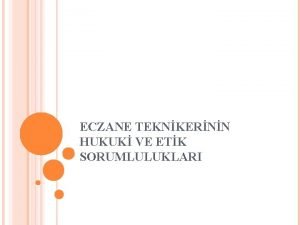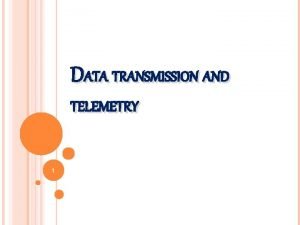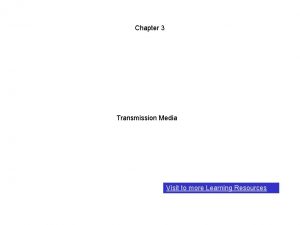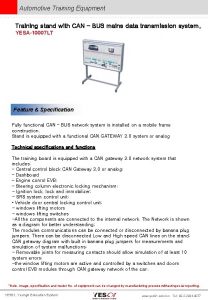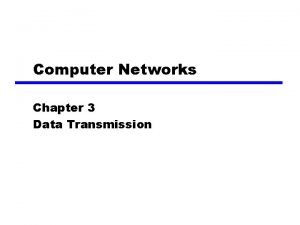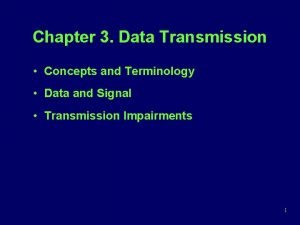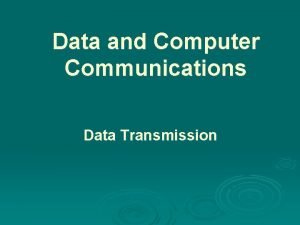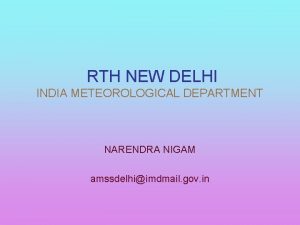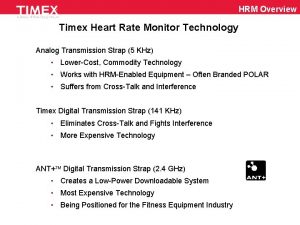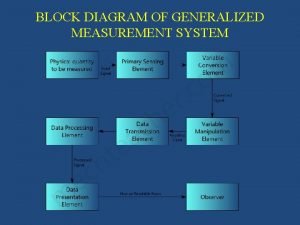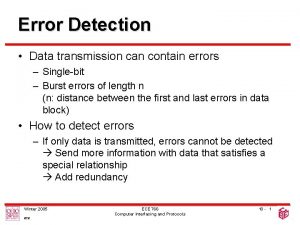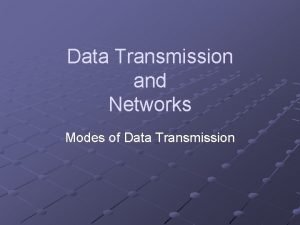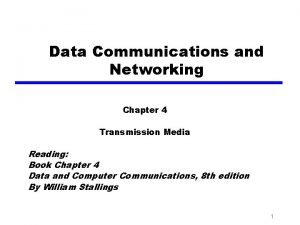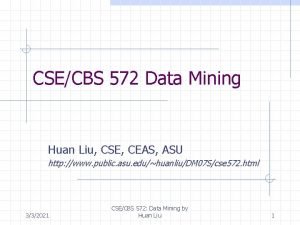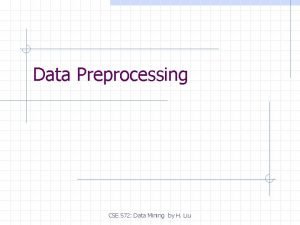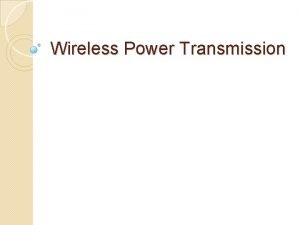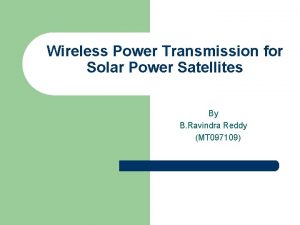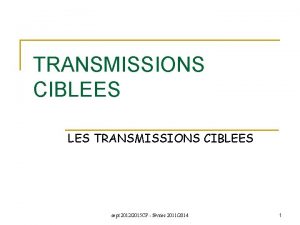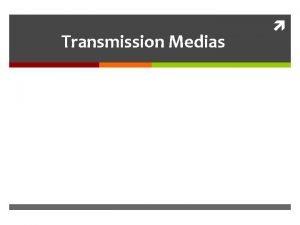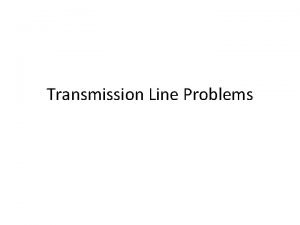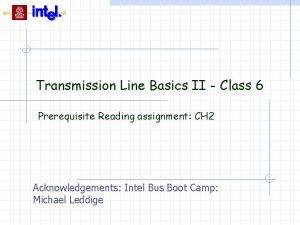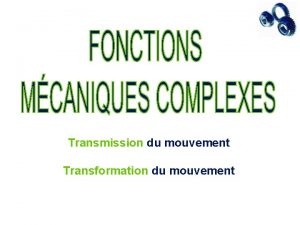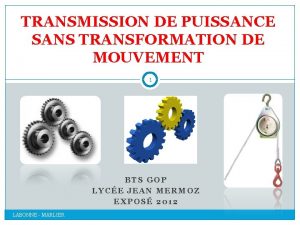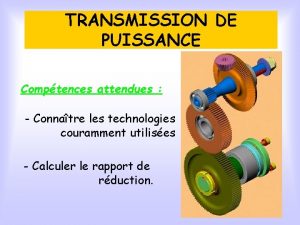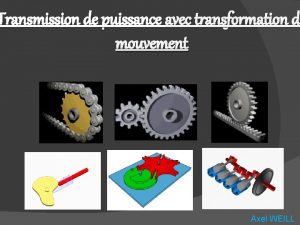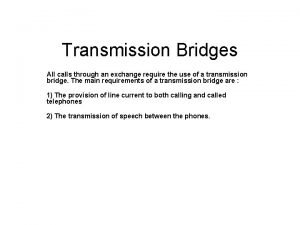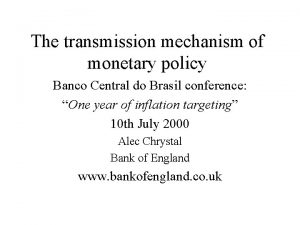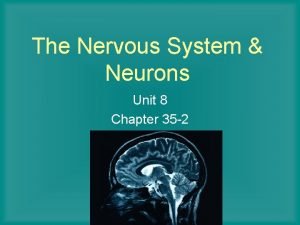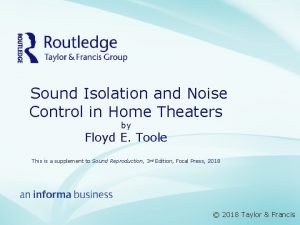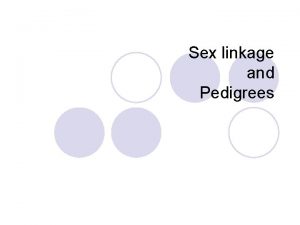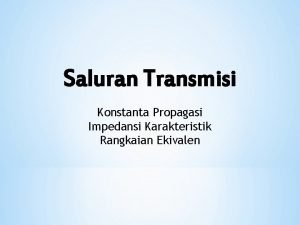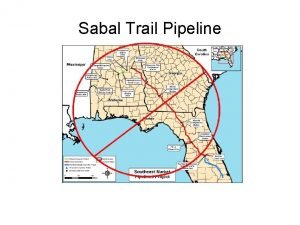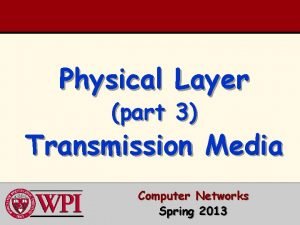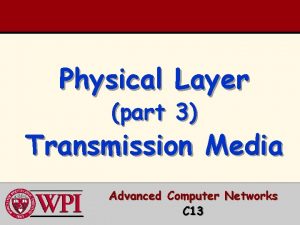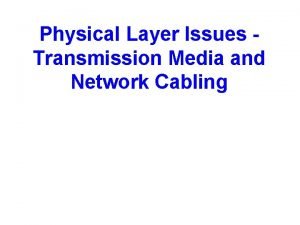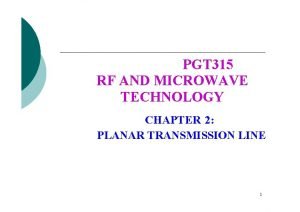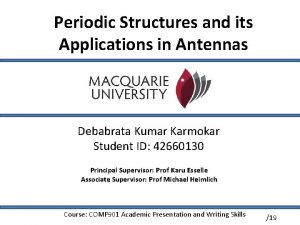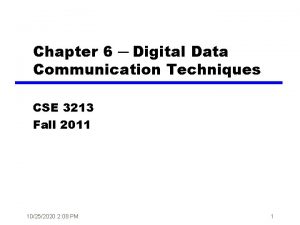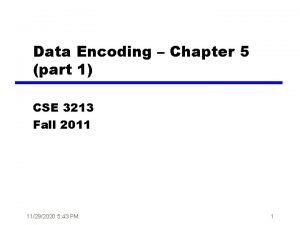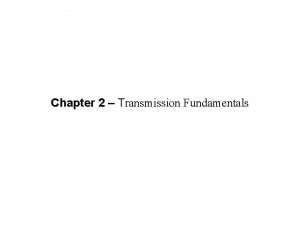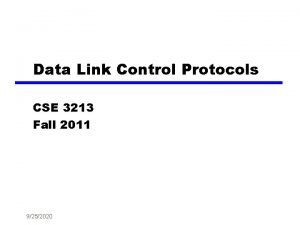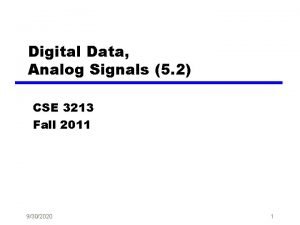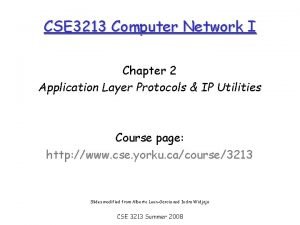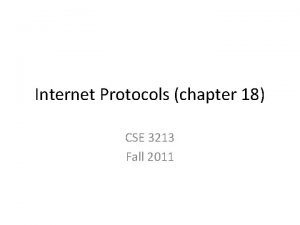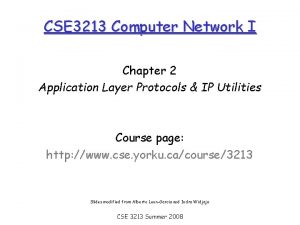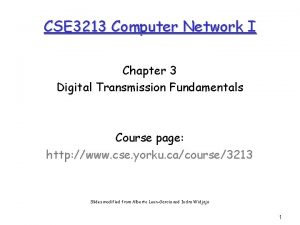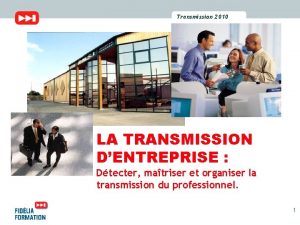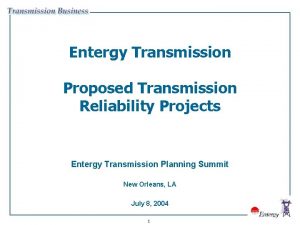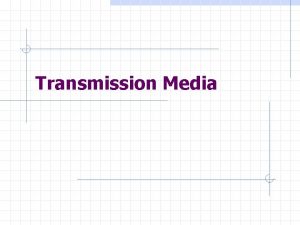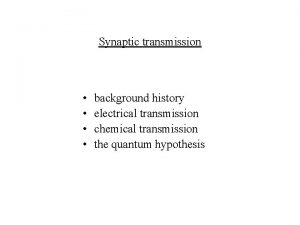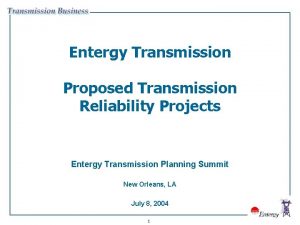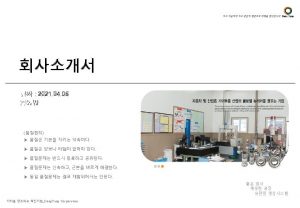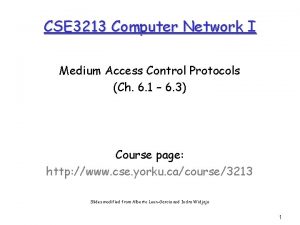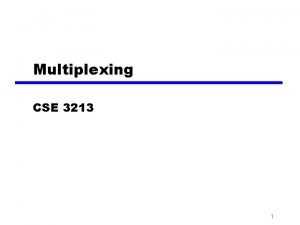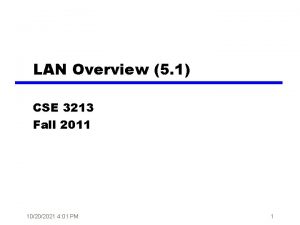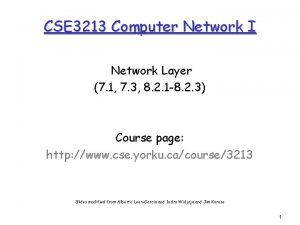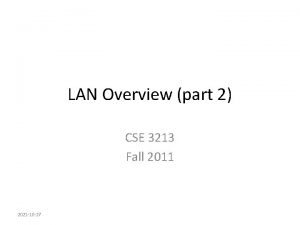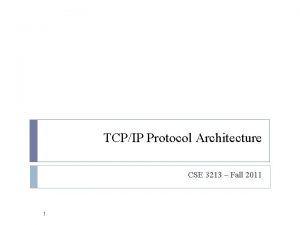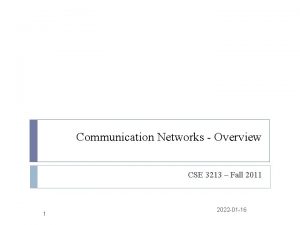Chapter 3 Data Transmission CSE 3213 1 Data
























![Signal with DC Component (a) s(t)=1+(4/π)[Sin(2πft)+(1/3)Sin(2π(3 f)t)] Bandwidth B = 3 f – f Signal with DC Component (a) s(t)=1+(4/π)[Sin(2πft)+(1/3)Sin(2π(3 f)t)] Bandwidth B = 3 f – f](https://slidetodoc.com/presentation_image_h2/4cda7618e06ba302f113af4b2f6fc061/image-25.jpg)

























- Slides: 50

Chapter 3 ─ Data Transmission CSE 3213 1

Data Transmission • quality of the signal being transmitted The successful transmission of data depends on two factors: 2 • characteristics of the transmission medium

Transmission Terminology Data transmission occurs between transmitter and receiver over some transmission medium. Communication is in the form of electromagnetic waves. 3 Guided media twisted pair, coaxial cable, optical fiber Unguided media (wireless) air, vacuum, seawater

Transmission Terminology (2) Direct link • no intermediate devices Point-to-point • direct link • only 2 devices share link Multi-point 4 • more than two devices share the link

Transmission Terminology (3) Simplex signals transmitted in one direction eg. television Half duplex both stations transmit, but only one at a time eg. police radio Full duplex simultaneous transmissions eg. telephone 5 Note: elsewhere, half duplex is called “simplex”; full duplex is called “duplex” (ITU-T definitions)

Analog and Digital Data Transmission Data Entities that convey meaning, or information (data ≠ info) Signals Electric or electromagnetic representations of data Signaling Physical propagation of the signal along a medium Transmission Communication of data by propagation and processing of signals 6

Analog and Digital Data Analog Continuous values within some interval e. g. sound, video Digital Discrete values e. g. text, integers 7

Analogue and Digital Signals 8

Analog Signals 9

Digital Signals 10

Advantages & Disadvantages of Digital Signals cheaper less susceptible to noise but greater attenuation digital now preferred choice 11

Frequency, Spectrum and Bandwidth Time domain Example: a sine wave, a square wave Frequency domain Signal usually made up of many components of different frequencies Components are sine waves More important than time domain

Time Domain Concepts Analog signal Various in a smooth way over time (continuous) Digital signal Maintains a constant level then changes to another constant level (discrete) Periodic signal Pattern repeated over time Aperiodic signal Pattern not repeated over time 13

Periodic Signals 14

Sine Wave Periodic continuous signal Peak Amplitude (A) maximum strength of signal volts Frequency (f) rate of change of signal Hertz (Hz) or cycles per second period = time for one repetition (T) T = 1/f Phase ( ) relative position in time 15

Examples of Sine Waves s(t) = A sin(2 ft + ) 16

Analog Signaling Frequency and peak amplitude are the most amplitude (volts) important. 1 cycle phase difference time (sec) frequency (hertz) = cycles per second 17

Wavelength ( ) the wavelength of a signal is the distance occupied by a single cycle can also be stated as the distance between two points of corresponding phase of two consecutive cycles 18 assuming signal velocity v, then the wavelength is related to the period as = v. T especially when v = c • c = 3 x 108 m/s (speed of light in free space) or equivalently f = v

Frequency Domain Concepts Signal usually made up of many frequencies Components are sine waves Can be shown (Fourier analysis) that any signal is made up of components at various frequencies; each component is a sine wave fundamental frequency period of total signal = period of fundamental frequency harmonic frequency = a multiple of fundamental frequency Can plot frequency domain functions 19

20

Addition of Frequency Components (T = 1/f) (a) sin(2πft) (c) is the sum of f and 3 f (b) (1/3)sin(2π(3 f)t) (c) (4/π)[sin(2πft)+(1/3)sin(2π(3 f)t)] 21

Frequency Domain S(f) is discrete Figure a is discrete because the time domain function is periodic. Figure b is continuous because the time domain function is aperiodic. (a) Frequency domain function for s(t)=(4/π)[sin(2πft)+(1/3)sin(2π(3 f)t)] Single square pulse S(f) is continuous 22 (b) Frequency domain function for a single square pulse s(t)=1 for -X/2<t<X/2

Original Time -> Harmonic spectrum As we add more harmonics the signal reproduces the original more closely 23

Spectrum and Bandwidth Spectrum range of frequencies contained in signal Absolute bandwidth of spectrum Effective bandwidth (or just bandwidth) narrow band of frequencies containing most of the energy DC Component of zero frequency No DC component average amplitude = 0 DC component is undesirable (avg amplitude 0) 24
![Signal with DC Component a st14πSin2πft13Sin2π3 ft Bandwidth B 3 f f Signal with DC Component (a) s(t)=1+(4/π)[Sin(2πft)+(1/3)Sin(2π(3 f)t)] Bandwidth B = 3 f – f](https://slidetodoc.com/presentation_image_h2/4cda7618e06ba302f113af4b2f6fc061/image-25.jpg)
Signal with DC Component (a) s(t)=1+(4/π)[Sin(2πft)+(1/3)Sin(2π(3 f)t)] Bandwidth B = 3 f – f = 2 f 25

Data Rate and Bandwidth Data rate In bits per second Rate at which data can be communicated Bandwidth In cycles per second, or Hertz Constrained by transmitter and medium Channel: a communication path 26

Data Rate and Bandwidth any transmission system has a limited band of frequencies limiting bandwidth creates distortions 27 this limits the data rate that can be carried on the transmission medium most energy in first few components square waves have infinite components and hence an infinite bandwidth There is a direct relationship between data rate and bandwidth.

Example Case 1: f = 1 MHz R = ? Mbps B = ? MHz Case 2: f = ? MHz B = 8 MHz R = ? Mbps Case 3: f = ? MHz B = 4 MHz R = ? Mbps 28

Data Rate and Bandwidth (3) Consider a square wave Data rate R = 2 x f (f: fundamental frequency) Double the bandwidth double the data rate (other things being equal) A given bandwidth can support different data rates (e. g. , by removing the component with the highest frequency). However, it’s harder for the receiver to interpret the received signal if R is high (i. e. , more chances for errors). 29

Data Rate and Bandwidth (4) In general, The greater the bandwidth the higher the data rate The higher the data rate The greater the required effective bandwidth Keeping the same data rate: Greater bandwidth better quality of the received signal, but greater cost The higher center frequency the higher the potential bandwidth 30

Transmission Impairments (3. 3) Signal received may differ from signal transmitted Analog - degradation of signal quality Digital - bit errors Caused by Attenuation and attenuation distortion Delay distortion Noise 31

Attenuation Signal strength falls off with distance Solutions: use repeaters, amplifiers Depends on medium Received signal strength: must be enough to be detected must be sufficiently higher than noise to be received without error Attenuation distortion Attenuation is an increasing function of frequency. Solution: equalization (amplifying high frequencies more than low frequencies) Less of a problem with digital signals (why? ) 32

Attenuation and Delay Distortion 33

Delay Distortion occurs because propagation velocity of a signal through a guided medium varies with frequency highest velocity near the center frequency various frequency components arrive at different times resulting in phase shifts between the frequencies particularly critical for digital data since parts of one bit spill over into others causing inter-symbol interference solution: equalization 34

Noise 35 unwanted signals inserted between transmitter and receiver is the major limiting factor in communications system performance

Categories of Noise (1) Thermal noise • due to thermal agitation of electrons • uniformly distributed across bandwidths • referred to as white noise Intermodulation noise 36 • produced by nonlinearities in the transmitter, receiver, and/or intervening transmission medium • effect is to produce signals at a frequency that is the sum or difference of the two original

Categories of Noise (2) Crosstalk: a signal from one line is Impulse Noise: caused by external 37 electromagnetic interferences noncontinuous, consisting of irregular pulses or spikes short duration and high amplitude minor annoyance for analog signals but a major source of error in digital data picked up by another can occur by electrical coupling between nearby twisted pairs or when microwave antennas pick up unwanted signals

Effect of noise Signal Noise Logic Threshold Signal+Noise Sampling times 0 1 1 0 0 1 0 1 Data Received Original data Bit error 38

Thermal (White) Noise Due to thermal agitation of electrons Uniformly distributed N = k. TB (watts) k = Boltzmann’s constant = 1. 38 x 10 -23 J/K T = kelvin degrees; B = bandwidth in Hz 39

Signal to Noise Ratio (SNR) Noise effects distorts a transmitted signal attenuates a transmitted signal-to-noise ratio to quantify noise: S/N usually expressed using d. B SNRd. B = 10 log 10 S N S= average signal power N= noise power 40

Channel Capacity (3. 4) The maximum rate at which data can be transmitted over a given communication path, or channel, under given conditions. 4 related factors: data rate, bandwidth, noise, error rate (see next slide). Our goal: get as high a data rate as possible at a particular limit of error rate for a given bandwidth. The main constraint on achieving this efficiency is noise. 41

Channel Capacity (cont. ) Data rate In bits per second Rate at which data can be communicated Bandwidth In cycles per second of Hertz Constrained by transmitter and medium Noise Average level of noise over the communication path Error rate Error: 1 becomes 0; 0 becomes 1 At a given noise level, higher data rate higher error rate (Fig 3. 16) 42

Nyquist Bandwidth Assume noise-free channels Channel bandwidth limits the signal/data rate Given bandwidth B, highest signal rate is 2 B: C = 2 B If rate of signal transmission is 2 B then signal with frequencies no greater than B is sufficient to carry signal rate Given binary signal, data rate supported by B Hz is 2 B bps Can be increased by using M signal levels: C= 2 B log 2 M however this increases burden on receiver noise and other impairments limit the value of M 43

Nyquist Bandwidth: Example Binary signals B = 3, 100 Hz C = 2 B = 6, 200 bps Multi-level signal M = 8 C= 2 B log 2 M = 2 x 3100 x 3 = 18, 600 bps Higher bit rate with the same bandwidth Drawback? 44

Shannon Capacity Formula Consider data rate, noise and error rate Higher data rate shortens each bit so burst of noise affects more bits At given noise level, high data rate means higher error rate Capacity C = B log 2(1 + S/R) S/R = (signal power)/(noise power) Typically measured at the receiver Assumes only thermal noise much lower rates are achieved in practice due to impulse noise, attenuation distortion, delay distortion, etc. Increase data rate by increasing S? Or increasing B? 45

decibel (d. B) Normal ratio = Pout/Pin 1 bel (B) = log 10(Pout/Pin) (devised by engineers of Bell Telephone Lab, named after Alexander Graham Bell) 1 decibel (d. B) = 10 B = 10 log 10(Pout/Pin) Note: this is dimensionless unit (a ratio) 3 d. B ≈ doubling of power 10 log 10(2) = 10 x 0. 3 = 3 6 d. B ≈ 4 times the power 46

Why d. B and not simple ratio? Signal strength often falls off exponentially. Net gain/loss in a cascaded path can be calculated with simple addition/subtraction. Signal to noise ratio (in decibels) SNRd. B= 10 log 10 (signal/noise) Note: “S/R” in the Shannon capacity formula is a normal ratio, not d. B. See Example 3. 6 in the textbook. 47

Exercises Calculate thermal noise for an effective noise temperature of 27 o. C and a 10 MHz bandwidth. Given a channel for digital signals with a bandwidth of 1 KHz, is it possible to transmit data at a rate of 6 Kbps along this channel? If so, describe a method any conditions that must be satisfied. If not, explain why. Repeat the previous problem for a data rate of 1 Kbps 48

Exercises (2) Given a square wave signal represented by the following Fourier series: x(t) = cos(2 ft) – (1/3)cos(6 ft) + (1/5)cos(10 ft) – (1/7)cos(14 ft) The fundamental frequency of the signal is 5 KHz. 1. What is the effective bandwidth of the signal? 2. What is the data rate supported by the signal? Given a SNR of 20 d. B, calculate the capacity of a channel with a bandwidth of 1 KHz. 49

Required Reading Chapter 3 Reference: Appendix 3 A (decibels) 50
 Geb 3213
Geb 3213 Isco 08:3213
Isco 08:3213 Chapter 19 disease transmission and infection prevention
Chapter 19 disease transmission and infection prevention Chapter 19 disease transmission and infection prevention
Chapter 19 disease transmission and infection prevention Chapter 15:8 using sterile techniques
Chapter 15:8 using sterile techniques Chapter 19 disease transmission and infection prevention
Chapter 19 disease transmission and infection prevention Landline telemetry system
Landline telemetry system Digital data transmission
Digital data transmission Transmission media in data communication
Transmission media in data communication Automobile data transmission system can bus training stand
Automobile data transmission system can bus training stand Transmission terminology in data communication
Transmission terminology in data communication Baseband binary data transmission system
Baseband binary data transmission system Transmission terminology
Transmission terminology Transmission terminology
Transmission terminology Amss chennai data transmission
Amss chennai data transmission Timex ironman hrm
Timex ironman hrm Block diagram of generalized instrumentation system
Block diagram of generalized instrumentation system Crc error detection
Crc error detection Parallel transmission mode
Parallel transmission mode Transmission medias
Transmission medias Cse 572 data mining
Cse 572 data mining Cse 572
Cse 572 Advantages and disadvantages of wireless power transmission
Advantages and disadvantages of wireless power transmission Wireless power transmission project report doc
Wireless power transmission project report doc Source
Source Factors that affect disease transmission
Factors that affect disease transmission Macro cible exemple
Macro cible exemple Guided media
Guided media Lossless transmission line examples
Lossless transmission line examples Transmission line basics
Transmission line basics Came et tige poussoir
Came et tige poussoir Transmission de puissance
Transmission de puissance Transmission de puissance
Transmission de puissance Transmission de puissance avec transformation de mouvement
Transmission de puissance avec transformation de mouvement Transmission bridge
Transmission bridge Transmission mechanism
Transmission mechanism Nerve impulse transmission steps
Nerve impulse transmission steps Les supports de transmission
Les supports de transmission Best and taylor
Best and taylor Solar power satellites and microwave power transmission
Solar power satellites and microwave power transmission X linked recessive transmission
X linked recessive transmission Konstanta fasa
Konstanta fasa Sabal trail transmission
Sabal trail transmission Pneumatic power transmission
Pneumatic power transmission Pkn sebagai pendidikan disiplin ilmu
Pkn sebagai pendidikan disiplin ilmu Transmission media in computer network
Transmission media in computer network كبيل
كبيل Transmission media
Transmission media Microstrip transmission line
Microstrip transmission line Microstrip transmission line
Microstrip transmission line Codage
Codage

